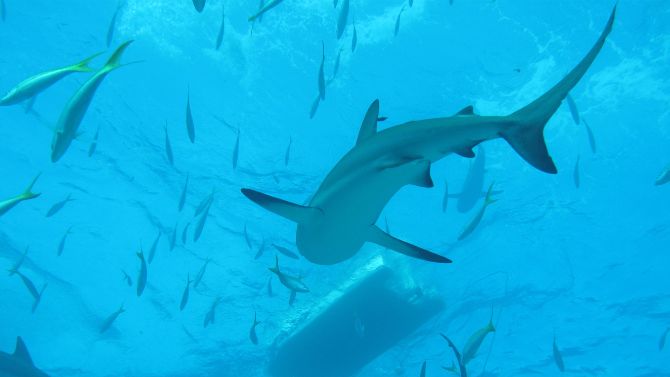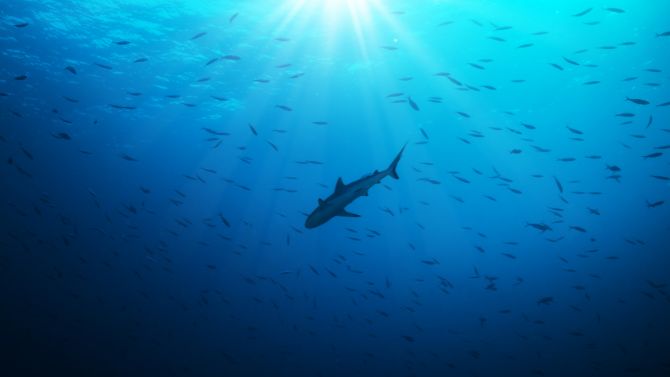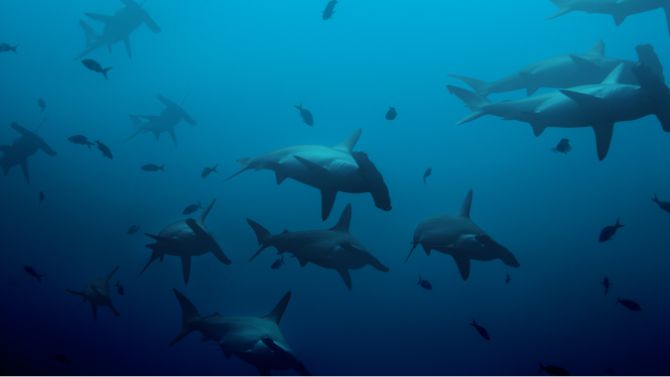Sharks, these ancient, mysterious creatures, have been a focal point of many myths, legends, and misconceptions. One such misconception revolves around their supposed taste for humans.
We’ve all seen the dramatic movie scenes where sharks are portrayed as bloodthirsty man-eaters. But what is the truth behind these notions? Are we a favorite meal for these denizens of the deep, or is there more to the story?
Why Sharks Attack Humans
It’s crucial to understand the reasons behind shark attacks on humans. Contrary to popular belief, these incidents aren’t always about hunger.
Mistaken Identity
Most of the attacks on humans are a result of mistaken identity.
- Curiosity: Sharks, like many animals, are curious creatures. When they come across something unfamiliar in their territory, they might take an exploratory bite.
- Silhouette: From below, a person floating on a surfboard or swimming can resemble a seal or turtle – favorite meals for some species.
- Splashing: Vigorous movements and splashing in water can attract sharks. They associate such motions with distressed or injured prey, making them investigate the commotion.
Territorial Behavior
Sharks are incredibly territorial. When humans unknowingly enter their territory, they might perceive them as potential threats.

- Defensive Bites: Not all bites are offensive. Many are defensive, warning the intruder to stay away from their territory or their prey.
- Rivalry: Just like any other animal, they may mistake humans for rival predators. A bite, in this case, can be a warning or an attempt to eliminate competition.
The Taste Factor
Let’s dive into the main topic of discussion: do sharks actually like the taste of humans?
Dietary Preferences
They have a varied diet, and it depends significantly on the species.
- Smaller Species: Species like the Nurse shark typically eat crustaceans, mollusks, and small fish.
- Larger Predatory Species: Great white, tiger, and bull sharks prefer seals, sea lions, and large fish.
Given these preferences, humans are not a regular menu item. When they do bite humans, they often release them after realizing the error.
Taste Buds and Nutrition
Sharks do have taste buds, but they function differently than ours. They can discern between different tastes, but they mainly seek nutritious food.
- Nutrient-rich Blubber: Seals and sea lions are rich in fat, making them nutritious meals. Humans lack the thick layer of blubber that many marine mammals possess.
- Release After the First Bite: Many attack survivors report that the shark released them after one bite. This behavior suggests that once the animal realizes the human isn’t the usual fatty, nutrient-rich prey, it loses interest.
Myths and Fiction
There are many myths surrounding sharks, often influenced by media portrayal. Let’s debunk some of the most common ones.

“All Sharks Are Man-eaters”
Only a fraction of species have ever been known to attack humans.
- Hundreds of Species: Of the 400+ species, only about a dozen have been involved in attacks on humans.
- Rare Incidents: Statistically, you are more likely to be struck by lightning or bitten by a dog than attacked by a shark.
“Sharks Hunt Humans Actively”
They don’t actively hunt humans. Most incidents are circumstantial or accidental.
- Feeding Habits: They primarily hunt for food, and as discussed earlier, humans aren’t a preferred meal.
- Accidental Encounters: Many attacks happen in their feeding grounds or breeding territories. In these cases, humans accidentally end up being in the wrong place at the wrong time.
Sharks in Popular Culture
It’s no secret that sharks have a formidable presence in our movies, books, and folklore. But how has this portrayal impacted our perception and the realities of these ocean dwellers?

The “Jaws” Effect
Few can forget the haunting theme music from the movie “Jaws.” Its release in 1975 brought a tidal wave of fear regarding sharks.
- Exaggerated Aggression: While the movie is iconic, its portrayal of a shark as a relentless human hunter was far from accurate.
- Increased Fear: Post “Jaws,” many beachgoers became wary of entering the water, fearing a shark would be lurking nearby, waiting to attack.
The Redemption Arc
As science advanced and more research was conducted on these animals, the narrative began to shift.
- Documentaries: Shows like “Shark Week” on the Discovery Channel have been instrumental in showcasing the true nature of these animals, emphasizing conservation and debunking myths.
- Conservation Efforts: As the reality behind sharks became clearer, many movements and organizations began emphasizing their protection, given the pivotal role they play in maintaining marine ecosystems.
Human Impact on Shark Populations
While the fear is rampant, the actual threat is often the other way around.

Overfishing and Bycatch
One of the significant threats sharks face today is from fishing.
- Targeted Hunting: Due to the demand for shark fins, especially in certain Asian cuisines, many are hunted and killed, their fins severed, and the rest of the body discarded.
- Accidental Captures: Even when not directly hunted, sharks often get caught in fishing nets and equipment, leading to unintentional deaths.
Habitat Destruction
Sharks also face the challenge of habitat destruction, primarily due to human activities.
- Pollution: The dumping of waste and toxins into oceans affects the water quality, impacting the food sources and health of marine life.
- Climate Change: The changing temperatures affect ocean currents, prey distribution, and breeding grounds, challenging sharks’ survival and reproduction.
Building a Harmonious Relationship

Our coexistence with sharks is not just possible but essential for the balance of marine ecosystems.
Awareness and Education
The first step towards peaceful coexistence is understanding.
- Spreading Knowledge: We must strive to educate ourselves and others about the true nature of sharks, dispelling myths and focusing on facts.
- Safety Precautions: While attacks are rare, knowing safety measures when swimming or diving in shark-infested waters can minimize risks.
Conservation Measures
Our oceans thrive when sharks thrive.
- Protecting Habitats: Implementing measures to reduce pollution and protect breeding grounds can ensure healthier shark populations.
- Regulating Fishing: By setting limits, using safer fishing methods, and reducing the demand for shark products, we can ensure their survival for generations to come.
FAQs
Are certain shark species more prone to attacking humans than others?
Yes, while any large species can potentially pose a threat, the majority of attacks on humans can be attributed to a small subset.
The Great White, Bull, and Tiger sharks are the three species most commonly involved in significant attacks. However, it’s essential to remember that such incidents are still infrequent compared to other hazards.
Do colors or patterns on swimwear attract sharks?
Some studies suggest that they may be more attracted to high-contrast colors and specific patterns (like stripes) as they resemble the natural patterns of some prey species. However, there’s no definitive evidence to say that a particular swimwear color guarantees safety or heightened risk.
Is it true that sharks can sense fear? They have an acute electroreceptive sense, allowing them to detect the electric fields produced by all living organisms, including humans.
While they can’t “sense fear” in the way we might think, sudden, erratic movements or an increased heart rate could produce changes in these fields. However, it’s unclear how sensitive sharks are to such minor variations.
Are there specific regions in the world where shark attacks are more prevalent?
These attacks, though rare, do tend to be more frequent in certain areas, often due to the confluence of human activity and shark habitats. Regions like Western Australia, parts of the South African coast, and certain beaches in Florida have recorded higher incidences.
Still, it’s crucial to contextualize this with the volume of people in the water and the presence of shark-attracting factors.
How does shark behavior change during different times of the year?
The behavior can change based on various factors, including breeding season, migration patterns, and food availability. For instance, during mating seasons, these animals might be more territorial.
Migration patterns could lead to an increased presence of certain species in specific areas during parts of the year, influencing the likelihood of encounters.
Final Words
Sharks, despite their fearsome reputation, are not the bloodthirsty man-eaters that movies and myths make them out to be. Most shark attacks on humans result from mistaken identity, territorial disputes, or sheer curiosity.
The taste of human flesh doesn’t particularly appeal to them, given their dietary preferences for fattier, nutrient-rich prey.
By dispelling these myths and understanding the real nature of these incredible creatures, we can coexist peacefully and appreciate them for the vital role they play in our ocean ecosystems.






